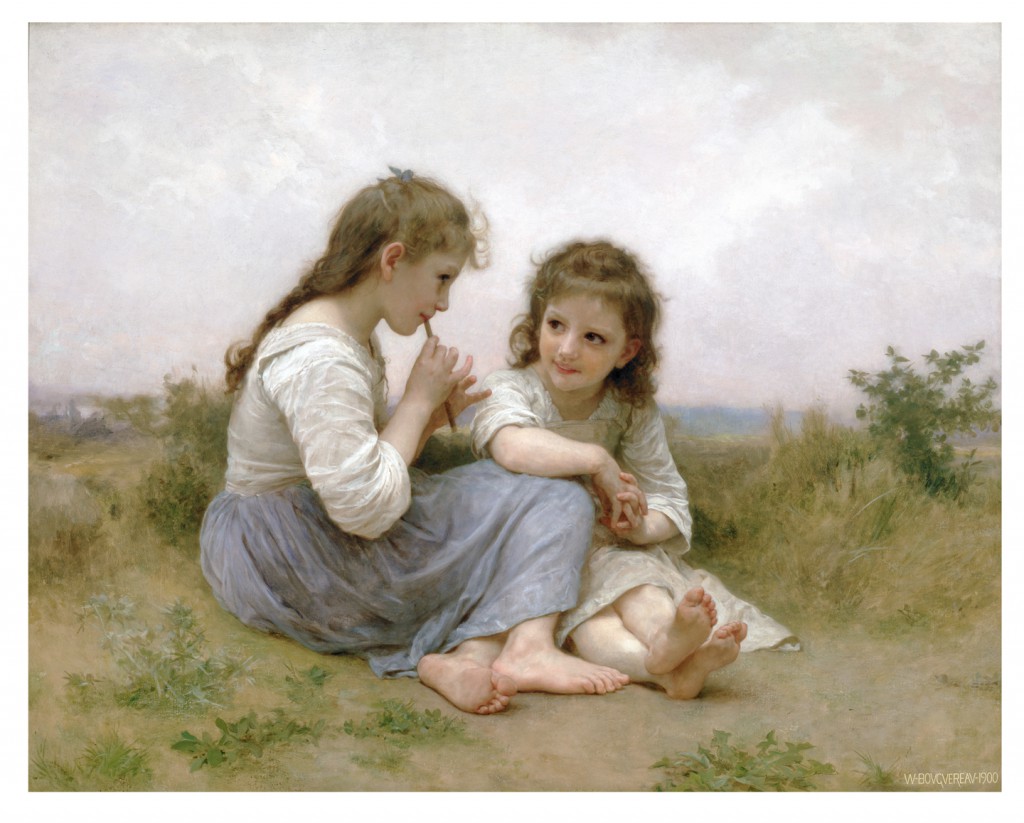Students will examine the artistic characteristics of Childhood Idyll, explain the characteristics of an idyll poem, and create an idyll poem inspired by Childhood Idyll or a familiar place.
Students will be able to:
- examine the artistic characteristics of Childhood Idyll;
- locate France on a map of the world and identify some defining features of the country;
- explain the characteristics of an idyll poem; and
- engage in multiple steps of the writing process and create an idyll poem inspired by Childhood Idyll.
Lesson
- Display Childhood Idyll and invite students to look carefully and share what they observe. Prompt them with the following questions: How would you describe the painting? How would you describe the girls? How would you describe the setting? How would you describe the colors? What adjectives or phrases might you use to communicate the “feel” of this painting?
- Share with students that Childhood Idyll was created by William-Adolphe Bouguereau of France in 1900. Tell students that an idyll is a poem, prose piece, or event depicting a rural and tranquil scene, usually in idealized terms. The word “idyll” is derived from the Greek word eidyllion, which means "little picture."
- Ask students: How is this title fitting? How does it not fit with the work? Is it your version of ideal? Why or why not? Discuss how the girls in this painting are images of idyllic innocence. Bouguereau made his paintings look timeless; instead of portraying the girls in the latest fashions, he painted them wearing peasant-type clothing that could belong to several different centuries. Refer to the About the Art section for more information.
- Tell the students that they will have an opportunity to write idyll poems. Provide the students with a couple of examples by visiting websites such as the following:
- Challenge students to think about what people would write idylls about in today’s world. What aspects of the countryside would be perfect for such a poem? Could you articulate a place you have been or where you live in an idyll? Encourage the students to create an idyll poem about Childhood Idyll or a place with which they are familiar. Encourage students to think about how the class described the painting and how they could use this type of language in their descriptive idyll.
- Once students have created their first drafts, have them trade papers with a classmate for constructive feedback on how to improve their writing.
- When the students have finished their idyll poems, invite them to break into small groups and share their written pieces with each other and discuss the similarities and differences between them. Challenge students to consider how students in different parts of the world or of different ages would write an idyll poem.
Materials
- Lined paper and pen/pencil for each student
- Large piece of chart paper and colored markers or (interactive) whiteboard for recording students’ ideas
- Ability to display information from the Internet to the students
- Map of the world, visible to all students in the classroom
- Internet access to the following website:
- About the Art section on Childhood Idyll
- One color copy of the painting for every four students, or the ability to project the image onto a wall or screen
Standards
- Social Studies
- History
- Become familiar with Western Hemisphere historical eras, groups, individuals and themes
- Visual Arts
- Observe and Learn to Comprehend
- Envision and Critique to Reflect
- Language Arts
- Oral Expression and Listening
- Research and Reasoning
- Writing and Composition
- Critical Thinking & Reasoning
- Information Literacy
- Invention
- Self-Direction
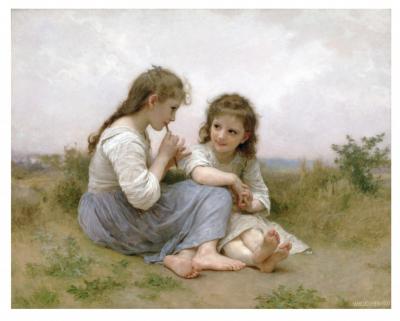
Childhood Idyll
William-Adolphe Bouguereau, France
1900
40.25 in. x 51.4 in.
Gift of the Lawrence C. Phipps Foundation, 1958.115
Photograph © Denver Art Museum 2009. All Rights Reserved.
Born in La Rochelle, France, William-Adolphe Bouguereau [BOO-guhr-oh] is often thought of as the typical French academic painter. After many years of studying, painting, and teaching in France and Italy, Bouguereau rose to prominence as the most famous French painter of his day. His combination of realism and idealism attracted many admirers. He cast many of his compositions in “ideal” ways, with figures based in part on classical statues as models. As one of the key supporters of the Salon (the official exhibition of contemporary art in Paris), Bouguereau showed his work there regularly for several decades. Although he lived during a time when artists were exploring new ways of painting, he never strayed from the conservative, academic style of painting he learned during his formative years. The response to his works was mixed: some found his work impressive for his technical skill, while others thought that the subjects were sappy and old-fashioned. Regardless, he is thought of as the European artist who set the academic standard for painting in the 1800s.
An idyll is a poem, prose piece, or event depicting a rural and tranquil scene, usually in idealized terms. The girls in this painting are images of idyllic innocence. Bouguereau probably created this painting during one of his frequent trips to La Rochelle, modeling it after local peasant children. Childhood Idyll reflects the classicism of academic painting in the late 1800s, which referred back to the art of ancient Greece and Rome. Bouguereau made his paintings look timeless: instead of portraying the girls in the latest fashions, he paints them wearing peasant-type clothing that could belong to several different centuries. Bouguereau’s painting process was long and painstaking; this painting is the result of months of dedicated research, sketching, and careful planning.
Details

Brushwork
The artist’s brushwork is virtually invisible. The figures are painted with thin layers of paint and almost no texture, leaving a smooth, glossy finish. There are only a few spots where you can see big fanned brushstrokes in the clouds, and short, wispy brushstrokes in the shrubs.
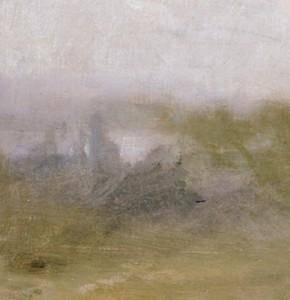
Atmospheric Haze
The perception of depth in nature can be enhanced with the use of atmospheric haze. This effect is achieved by using less focus and dull, blue hues for distant objects. The haze in this painting represents cloudiness, but can also indicate humidity, rain, snow, or smoke.
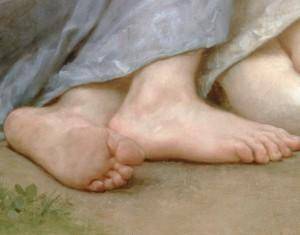
Foreshortening
Foreshortening is a technique artists use to create an illusion of depth, either by pushing an object forward or sending it back into space. Look at how much larger the older girl’s feet are compared to her head, for example. The difference in scale between the two anatomical parts suggests that the feet are closer to the viewer than her head.
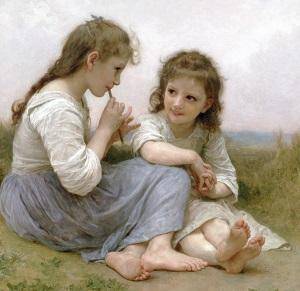
Composition
Composition is the arrangement of elements in a painting. The three main elements in this painting are the girls, the background, and the foreground grasses and shrubs. Bouguereau places his subjects in a space that’s rather like a stage. The two girls are seated center stage, facing the audience at a comfortable distance. The flat landscape and empty sky create a sense of expansiveness, dividing the background into two distinct spaces—the top and the bottom. Although one has the impression that this artwork was painted out of doors, it was actually a very planned and deliberate composition that the artist worked out in his studio.
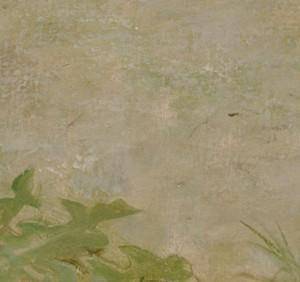
Color
Bouguereau gives his painting a rosy glow by using pinks and flesh tones to warm the otherwise cool whites and blues. Even the ground seems reddish. Bouguereau adds white and gray to his colors to give the work its soft, pastel effect.
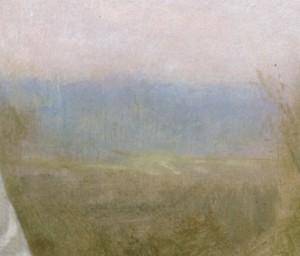
Line
Except for the dark outlines of the girls’ heads against the light sky, there are no strong lines in the painting. Boundaries are merely implied by subtle color shifts. Soft edges and interwoven colors allow our eyes to flow freely across the painting.
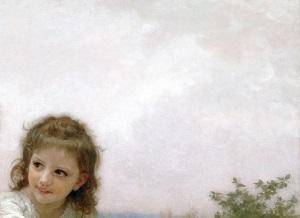
Light
The sunlight in this painting is diffused through the overcast sky, softening and muting the colors.
Funding for object education resources provided by a grant from the Morgridge Family Foundation. Additional funding provided by the William Randolph Hearst Endowment for Education Programs, and Xcel Energy Foundation. We thank our colleagues at the University of Denver Morgridge College of Education.
The images on this page are intended for classroom use only and may not be reproduced for other reasons without the permission of the Denver Art Museum. This object may not currently be on display at the museum.
